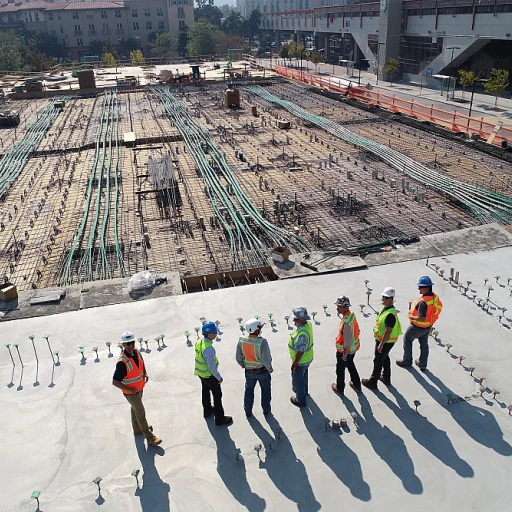
Identifying Future Leaders
Pinpointing Potential Leaders for the Future
Identifying future leaders within an organization is one of the core responsibilities of any executive team involved in succession planning. This process is crucial for ensuring the organization's sustained success and growth. As a strategic leader, it’s vital to recognize individuals within your team who possess leadership potential and the ability to grow into more significant leadership roles. When we talk about identifying future leaders, we must consider several factors:- Leadership Traits and Skills: Look for team members who exhibit strong decision making and strategic thinking abilities. These skills are often indicators of a person’s ability to take on higher leadership roles.
- Performance and Potential: Ensure that candidates not only excel in their current roles but also display potential for growth. This might include their willingness to take on new challenges and their ability to adapt within a dynamic work environment.
- Organizational Needs: The types of leadership you need may vary based on the organization's strategic goals. Understanding these needs helps in identifying candidates who can fulfill future leadership roles effectively.
Developing Leadership Skills
Fostering Essential Leadership Qualities
The second crucial step in succession planning is to ensure the development of robust leadership skills among potential future leaders. This is vital for preparing team members to take on leadership roles effectively. While identifying future leaders is important, nurturing their growth is equally vital for the stability and continuity of the organization. One of the primary responsibilities of a leader in succession planning is to establish a structured leadership development program. A comprehensive program equips team members with the necessary skills and strategic thinking required to excel in leadership roles. Business schools and executive education initiatives can offer valuable resources in shaping these programs.- Focus on Key Skills: Effective leadership development programs should prioritize skills such as decision making, strategic thinking, and communication, which are critical in the work environment.
- Diverse Leadership Education: Incorporate a variety of types of leadership and roles in leadership education to broaden the perspective and adaptability of future leaders.
- Practical Experience: Encourage a work environment that allows aspiring leaders to step into roles of responsibility, offering hands-on experience that is essential for their growth.
Creating a Succession Plan Framework
Crafting an Effective Framework for Seamless Successions
In the realm of succession planning, establishing a comprehensive framework is pivotal to securing an organization's future leadership. This framework acts as a strategic blueprint, outlining clear roles and responsibilities for potential leaders and team members. The objective is to ensure that everyone in the organization is aligned with the succession goals and understands the pathways to leadership. Creating such a framework begins with a detailed assessment of the current and anticipated needs of the organization. By evaluating existing leadership roles and the necessary skills required, you can identify any gaps that may impede future development. This ensures that the succession plan is realistic and geared towards achieving the long-term goals of the business. To build a robust framework, consider incorporating the following elements:- Clear Role Definitions: Define the roles and responsibilities explicitly for team leaders, decision makers, and strategic thinkers within the organization. This clarity helps in recognizing the exact attributes needed in future leaders.
- Leadership Development Programs: Implement leadership programs, which may include online courses or workshops, to nurture leadership skills. Programs like leadership development or executive education are vital in honing the skills necessary for effective leadership.
- Executive Education: Collaborate with institutions such as business schools to provide advanced training for potential successors. Developing strategic thinking and decision making in potential leaders strengthens your leadership pipeline.
- Regular Assessment and Feedback: Constant monitoring and adaptation of the succession plan are crucial. Regular assessments allow leaders to identify and groom promising team members for future leadership roles.
- Inclusive Team Collaboration: Foster an environment where team leaders and members work collaboratively towards seamless succession. This promotes internal growth and ensures that everyone feels valued and invested in achieving the organization's mission.
Communicating the Plan
Effectively Sharing the Succession Strategy
Communicating a succession plan within an organization is crucial to its success. This step ensures that all stakeholders, including team members, leadership roles, and the overall management, understand their roles and responsibilities in the transition process. Here’s how leaders can communicate the succession strategy effectively:- Engagement with Team Members: Leaders should engage team members in discussions about the succession plan, ensuring each member understands how the plan affects their roles and responsibilities. This built-in transparency contributes to a positive work environment and helps diminish uncertainty among team members.
- Streamlined Communication Program: Establish an online communication program that outlines the key elements of the succession plan. This can include education sessions, leadership program initiatives, or strategic thinking workshops, often facilitated by a team leader or executive.
- Clear Display of Leadership Roles: Visibly defining leadership roles and expectations within the plan reassures the team about the continuity of leadership and the organization’s direction. It’s essential to highlight the importance of leadership development and executive education to foster a culture of continuous growth.
- Feedback Channels: Implement feedback mechanisms to allow team members and executives to express their views on the succession plan. This feedback can help refine the process and address any concerns early on.
- Utilization of Leadership Skills: Leverage existing leadership skills among decision makers to communicate the importance of the plan effectively. It’s vital for leaders to not only embody strategic thinking and decision-making abilities but also exhibit qualities of communication and team organization.
Monitoring and Adapting the Plan
Continuous Monitoring and Adapting Strategies
Effective succession planning doesn't stop at developing a plan or identifying future leaders; it involves an ongoing process of monitoring and adapting the plan to meet the evolving needs of the organization. Successful organizations recognize the dynamic nature of the business environment and encourage a proactive approach to ensure their succession plans remain relevant and effective. To maintain relevance, leaders need to:- Engage Regularly with Team Members: By maintaining communication with team members, leaders can gain insights into individuals' aspirations, skill development, and potential leadership roles. This ongoing dialogue helps adjust the talent pipeline based on individual and organizational goals.
- Review and Update Skills Requirements: As industries and technologies evolve, the skills required for leadership roles may change. Monitoring these trends and integrating relevant skills into the leadership development program is crucial for future-proofing the organization's leadership roles.
- Evaluate Leadership Development Programs: Frequent assessments of existing leadership programs ensure they align with the strategic goals of the organization. Evaluations also reveal whether the programs effectively equip potential leaders with necessary skills like strategic thinking, decision making, and team management.
- Adapt to Changing Business Needs: Leaders must be adaptable, ready to pivot the succession framework as organizational and market conditions dictate. This may involve redefining roles, responsibilities, and expectations of future leaders.
- Foster a Collaborative Work Environment: Encouraging team leaders and members to actively participate in the succession process strengthens the organization's commitment to leadership development. Such collaboration aids in integrating diverse perspectives, leading to more robust decision-making processes.
Ensuring a Smooth Transition
Facilitating a Seamless Leadership Transition
Ensuring a smooth transition in leadership roles is a critical component of succession planning. It requires strategic thinking and careful management to maintain stability within the organization. A well-executed transition not only supports the incoming leader but also reassures team members and stakeholders about the continuity of the business.
Here are some key considerations to facilitate a seamless transition:
- Clear Communication: Open and transparent communication is essential. Inform all team members and stakeholders about the upcoming changes in leadership roles. This helps in managing expectations and reducing uncertainty within the team organization.
- Role Clarity: Clearly define the roles and responsibilities of the new leader. This includes outlining the goals and objectives they are expected to achieve. Providing clarity helps in aligning the team and ensuring everyone understands their roles within the new structure.
- Leadership Development: Prioritize leadership development programs to equip the new leader with the necessary skills. Executive education and leadership programs, such as those offered by a business school, can be instrumental in enhancing leadership skills and decision-making capabilities.
- Support Systems: Establish support systems to assist the new leader in their transition. This could include mentorship from experienced leaders or access to resources that aid in their development. A supportive work environment fosters confidence and encourages growth.
- Feedback Mechanisms: Implement feedback mechanisms to monitor the transition process. Regular check-ins with the new leader and team members can provide valuable insights into how the transition is progressing and highlight areas for improvement.
- Adaptability: Be prepared to adapt the succession plan as needed. The business landscape is dynamic, and flexibility in your approach can help address unforeseen challenges and ensure the transition remains on track.
By focusing on these areas, organizations can ensure that leadership transitions are smooth and effective, maintaining the momentum of the business and supporting the development of future leaders.












